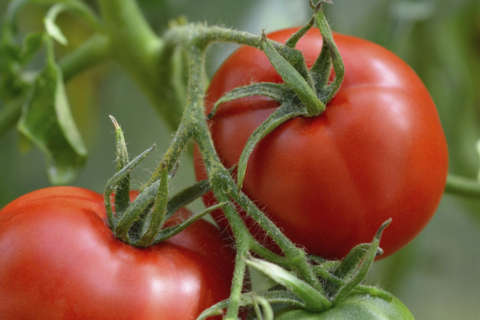Normally, planting tomatoes at any time of day in early to mid-May would be pretty risky, as there always seems to be one outlier night that chills the poor plants and limits their future production.
But not this year.
Nighttime temperatures were perfect for planting last week, and they’ll be even more perfect this coming week.
Even the daytime temperatures are moderate enough not to stress tomatoes with too much heat early in the season — but there is a scorcher in the forecast. So be sure and wait until after 5 or 6 p.m. to plant your tomatoes — and peppers, cukes, zukes and such.
Installing in the early evening allows the plants to get nice and settled before they have to experience their first hot and sunny day, and greatly reduces the risk of transplant shock.
How ‘determined’ are your tomatoes?
Before you plant, make sure you know which kind of tomato is going in the ground.
“Determinate” tomato plants are bred to be well-behaved and bushy, topping out at a mere 5 feet or less in height, and reaching that final height fairly early in the season. (They may have the words “bush,” “patio” or “container” in their description.) A normal-size tomato cage will keep such plants upright and tidy.
“Indeterminates” are just the opposite, growing until frost to a final vine height (or more appropriately, “length”) of 10 to 12 feet. These monsters require a specially designed cage to stay upright and contained (see below).
Not every supplier identifies their tomatoes by these designations, but many do. Check multiple catalog descriptions of your varieties names online — or be prepared for big problems in early July when Junior’s shoes don’t fit no more.
Caged love (apples, that is …)
If you have a small garden or are growing in containers, choose “determinate” type tomatoes; they’re bred to produce their fruits on plants that stay small and compact.
But the best-tasting tomatoes are produced on “indeterminate” plants, whose vines grow long, large and unwieldy over the course of a season. To contain these 10-to-12-foot-long vines:
- Get a roll of 5- or 6-foot-high welded wire animal fencing (not chicken wire; it’s too flimsy).
- Use wire cutters to cut it into 6-foot lengths.
- Cut the 6-foot length of cage off the main part of the roll in an “in-and-out” manner, so that one end of the cut section will have “loose” pieces of fencing sticking out along the cut edge. (The edge of what’s left on the roll should be “flush,” like the end of the roll before you started.)
- Use the “stick-out spikes” you’ve created like twist ties to hold the cage together in the shape of a cylinder.
- Center the cage over your planted tomato.
- Then drive two pieces of rebar or two strong stakes through the sides of the cage to hold it steady. Do not stake the actual plant; let it roam around the inside of the cage and use up all that non-linear room.
- Allow a good foot of open space between each cage for airflow.
Avoid disease issues upfront
Tomatoes are prone to many disease issues. These can be difficult to control after they strike, so let’s prevent them while growing “the gateway drug of gardening!”
- First, don’t plant in the exact same place where tomatoes have grown for the past two or three years, or “wilt” will yellow — and perhaps kill — the plants.
- Second, be sure to mulch the surface of the soil with compost. Do not mix the compost into the soil, and don’t use any other kind of mulch.
- Third, don’t crowd the plants; allow a solid foot of airflow between each plant.
- Fourth, use cages or other sturdy support to keep the plants upright and off the ground. Never let tomato plants sprawl, or slugs and rot will claim all the fruits.
- And fifth, water only in the early morning. Do not wet the leaves of any of your plants in the evening, especially tomatoes.
Find a refresher course on “Tomato Planting 101” here.
Mike McGrath was Editor-in-Chief of ORGANIC GARDENING magazine from 1990 through 1997. He has been the host of the nationally syndicated Public Radio show “You Bet Your Garden” since 1998 and Garden Editor for WTOP since 1999. Send him your garden or pest control questions at MikeMcG@PTD.net.







